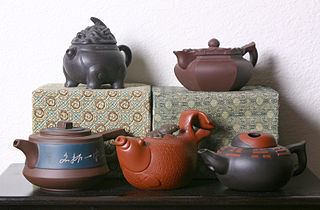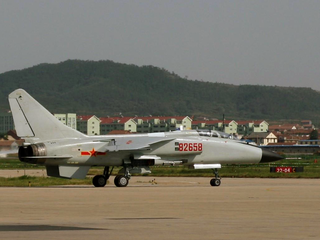
The Three Gorges are three adjacent and sequential gorges along the middle reaches of the Yangtze River path, in the hinterland of the People's Republic of China. With a subtropical monsoon climate, they are known for their scenery.

Yixing is a county-level city administered under the prefecture-level city of Wuxi in southern Jiangsu province, China, and is part of the Yangtze River Delta. The city is known for its traditional Yixing clay ware tea pots. It is a pene-exclave with Changzhou. The city spans an area of 1,996.6 square kilometres (770.9 sq mi), and has a registered hukou population of about 1,075,800 as of 2020.

After Liu Bang defeated Xiang Yu and proclaimed himself emperor of the Han dynasty, he followed the practice of Xiang Yu and enfeoffed many generals, noblemen, and imperial relatives as kings, the same title borne by the sovereigns of the Shang and Zhou dynasties and by the rulers of the Warring States. Each king had his own semi-autonomous kingdom. This was a departure from the policy of the Qin dynasty, which divided China into commanderies governed by non-hereditary governors.

Huzhou is a prefecture-level city in northern Zhejiang province. Lying south of the Lake Tai, it borders Jiaxing to the east, Hangzhou to the south, and the provinces of Anhui and Jiangsu to the west and north respectively. Huzhou is located on the south bank of Taihu Lake. It is named after the lake. It is an ancient city in the south of the Yangtze River with a history of more than 2,300 years. It currently governs Wuxing and Nanxun districts and three counties of Deqing, Changxing and Anji, with a total area of 5,818 square kilometers. As of the 2020 census, its population was 3,367,579 inhabitants, of whom 1,015,937 lived in the built-up area made of Wuxing District as Nanxun District is not being conurbated yet.

Yixing clay is a type of clay from the region near the city of Yixing in Jiangsu Province, China, used in Chinese pottery since the Song dynasty (960–1279) when Yixing clay was first mined around China's Lake Tai. From the 17th century on, Yixing wares were commonly exported to Europe. The finished stoneware, which is used for teaware and other small items, is usually red or brown in colour. Also known as zisha (宜興紫砂) ware, they are typically left unglazed and use clays that are very cohesive and can form coils, slabs and most commonly slip casts. These clays can also be formed by throwing. The best known wares made from Yixing clay are Yixing clay teapots, tea pets, and other teaware.

Sanming, also known as Minzhong, is a prefecture-level city in western Fujian province, China. It borders Nanping City to the north, Fuzhou City to the east, Quanzhou City to the southeast, Longyan City to the south and the province of Jiangxi to the west. Sanming lies between Wuyi and Daiyun mountains.

Fangshan District is a district of the city of Beijing. It is situated in the southwest of Beijing, 38 km (24 mi) away from downtown Beijing. It has an area of 2,019 square kilometres (780 sq mi) and a population of 1,312,778. The district is divided into 8 subdistricts, 14 towns, and 6 townships.

Mount Jiuhua located in Chizhou, Anhui Province in China is an important Buddhist site and natural scenic spot. It is one of the four famous Buddhist mountains in China, one of the first batch of 5A level scenic spots in China, one of the first batch of natural and cultural heritage sites in China, and the main scenic spot of "two mountains and one lake" tourism development strategy in Anhui Province. The planned area of the scenic spot is 120 square kilometers, and the protected area is 174 square kilometers, which is composed of 11 scenic spots.

Yunfu, formerly romanized as Wanfow, and historically known as Dong'an, which was formerly romanized as Tong On, from 1578 to 1913, is a prefecture-level city in western Guangdong province, People's Republic of China. It borders Zhaoqing to the north, Foshan to the east, Jiangmen to the southeast, Yangjiang to the south, Maoming to the southwest, and the autonomous region of Guangxi to the west. The city spans an area of 7,786.64 square kilometres (3,006.44 sq mi), and has a population of 2,383,400 according to a 2021 publication by the city government.

Anshun is a prefecture-level city located in southwestern Guizhou province, southwest China, near the Huangguoshu Waterfall, the tallest in China. As of the 2010 census, it had a population of 2,297,339. The city proper had a population of 765,313. Within the prefecture are attractions such as The Long Gong Dragon Caves and the Getu River.

Ancient Chinese coinage includes some of the earliest known coins. These coins, used as early as the Spring and Autumn period (770–476 BCE), took the form of imitations of the cowrie shells that were used in ceremonial exchanges. The same period also saw the introduction of the first metal coins; however, they were not initially round, instead being either knife shaped or spade shaped. Round metal coins with a round, and then later square hole in the center were first introduced around 350 BCE. The beginning of the Qin dynasty (221–206 BCE), the first dynasty to unify China, saw the introduction of a standardised coinage for the whole Empire. Subsequent dynasties produced variations on these round coins throughout the imperial period. At first the distribution of the coinage was limited to use around the capital city district, but by the beginning of the Han dynasty, coins were widely used for such things as paying taxes, salaries and fines.
Songzi is a city in the southwest of Hubei province, People's Republic of China, located in the middle reach and southern bank of the Yangtze River. It is a county-level city under the administration of the prefecture-level city of Jingzhou, and controls 16 townships and 2 development zones, 235,000 households and a population of 765,911. It is a long-historied but young and robust city.
Zhu is the pinyin romanization of five Chinese surnames: 朱, 祝, 竺, 猪 and 諸.

Laishan District is a district of the city of Yantai, Shandong province. It has an area of 258 square kilometres (100 sq mi) and around 181,200 inhabitants (2003).

Pujiang is a county of Zhejiang, China. It is under the administration of Jinhua city.

Wolong Gang is a cultural site and scenic area in the Chinese city of Nanyang, Henan. It is famous for having been the home of the strategist Zhuge Liang before his rise to prominence during the Three Kingdoms period. Zhuge lived in the area for about ten years, and it is now known by his epithet Wolong 卧龙, which means 'crouching dragon'.

Dongjiang Lake is a reservoir located in Chenzhou city, southeast Hunan province, China. It is close to the Beijing-Guangzhou Railway and China National Highway 107. Situated 38 km away from the downtown area, it covers an area of 200 square kilometers. The Dongjiang scenic area includes the following: the Dongjiang Lake landscape, Dongjiang Reservoir Dam, Hougu Mountain Rainfall, Yongcui Gorge, and Swan Mountain National Forest Park. It is well known in China as a place for tourism, vacation, and rehabilitation.

Middle Yandang Mountains or Zhong Yandang Shan refers, in the broad sense, to a coastal mountain range in southeastern Zhejiang Province in eastern China, which is close to Yandang Mountains, and both of them are parts of Yandang Ridge. It is said that people found that there was a lake in the top of the mountain, which was covered with reeds. And many wild geese lived there. Therefore, it is called "Yandang". It is historically called "the Best Mountain in Southeastern China". Comparing to Yandang Mountains, it seems like a religious interest rather than a geographic interest, which does not mean that Yandang Mountains are much better than Middle Yandang Mountains when it comes to natural landscape, but the latter is unique because of the religion. With cool climate and convenient traffic, as well as palatable sea food, it has been affirmed as one of the best ten summer resort in Zhejiang Province. It is said a Taoist priest, who believed in Taoism, came here and built a temple.

Xin dynasty coinage was a system of ancient Chinese coinage that replaced the Wu Zhu cash coins of the Han dynasty and was largely based on the different types of currencies of the Zhou dynasty, including knife money and spade money. During his brief reign, Wang Mang introduced a total of four major currency reforms which resulted in 37 different kinds of money consisting of different substances, different patterns, and different denominations.

Mount Mian, also known by its Chinese name Mianshan, is a mountain in the town of Mianshan in Jiexiu, Jinzhong, in central Shanxi Province in North China. Its official scenic area opened in the year 2000 and covers 75 km2 (29 sq mi), with about 400 attractions grouped into 14 tourist areas.

















